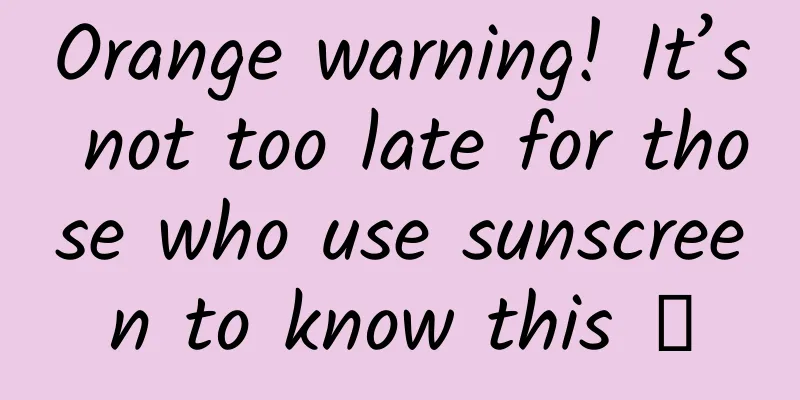Orange warning! It’s not too late for those who use sunscreen to know this →

|
Compiled by: Gong Zixin Not long ago The painful experience of the orange warning series Still fresh in my memory now The heat wave is back again... In addition to preventing heatstroke Sun protection is also a top priority Do you know how terrible it is to be exposed to UV radiation? Ultraviolet A with a longer wavelength Can reach below the skin Causes premature skin aging Shorter wavelength UVB Affects the outermost layer of the skin Causes sunburn and tanning The third type of ray - ultraviolet C Intercepted by the ozone layer that protects the Earth UVA and UVB can cause DNA mutations in skin cells These mutations accumulate over time. Causes tumor growth The American Skin Cancer Foundation The more UV exposure The greater the risk of skin cancer What is the sunscreen savior? ——It must be sunscreen! Sunscreen can be used in two ways Protect your skin from these malignancies: Chemical sunscreen Contains ingredients that absorb UV rays, such as avobenzone Physical sunscreen Rely on zinc oxide or titanium dioxide To block or reflect light No matter what Blocks solar radiation from penetrating the skin and damaging DNA However About Sun Protection and Sunscreen The following misunderstandings How many did you win? 01 As long as you don't get sunburned, you're safe. the truth: It's not just sunburn that puts your skin at risk. Dr. Henry Lim, a photodermatologist at Henry Ford Health in Detroit, said exposure to UV rays can damage the DNA of unprotected skin, and the effects are cumulative, even if your skin looks normal to the naked eye. "Every time the skin is exposed to the sun, whether or not there is a sunburn reaction, there is some skin damage that needs to be repaired. If this subclinical damage persists long enough, the skin's ability to repair all the DNA damage is compromised." 02 The body needs vitamin D, and sunscreen blocks it. the truth: Only a small amount of sunlight exposure is needed to produce the vitamin D your body needs. One study suggests that 5 to 10 minutes of sun exposure 2 to 3 times a week on the face, arms, and legs during the summer is enough to produce adequate amounts of vitamin D. Even with sunscreen, you'll still get minimal sun exposure, Lim said. "When using sunscreen, we often don't apply enough." People concerned about their vitamin D levels should protect their skin and seek out nutrients from food or take supplements, advises Anne Chapas, MD, a clinical instructor in dermatology at Mount Sinai Medical Center. 03 Chemicals in sunscreen can cause cancer. the truth: The active ingredients in sunscreens sold are regulated by the Food and Drug Administration and are deemed safe and effective. The National Academy of Sciences states that sunscreen use is not associated with higher rates of any type of cancer. In fact, quite the opposite, Chapas said: "If you don't want to get cancer, wear sunscreen." 04 No sun protection is needed when the UV index is very low. the truth: The UV index primarily measures medium-wave UVB rays, which Lim calls the "sunburn spectrum." Even if the UVB is low, you still need to protect yourself from UVA rays. "As long as there's light outside, there's enough long-wave UVB to induce tanning, create wrinkles, and increase your risk of skin cancer." Chapas agrees: "Even on a cloudy day, about 80 percent of the sun's rays get through and you can still get sun damage." 05 Dark skin doesn't need sunscreen. the truth: Anyone of any skin color can get skin cancer from sun damage. In fact, "skin cancer in patients with darker skin tones is often diagnosed at a later stage, when it is more difficult to treat," said Dr. Seemal Desai, president of the American Academy of Dermatology. Because dark skin is more susceptible to melanin production when exposed to the sun, dark skin is more susceptible to discoloration than light skin, Chapas said. 06 Physical sunscreens are safer than chemical sunscreens. the truth: Both sunscreens are safe to use, but physical sunscreens have fewer unknowns because they are not absorbed into the skin, Lim said. Chapas says this is one of the reasons she likes physical sunscreens, along with their versatility, since they can be worn over makeup or moisturizer. “The challenge is that some of these formulas have a white cast, so you have to find a formula that works with your skin tone.” 07 A tan protects your skin from sunburn. the truth: A tan provides a little bit of protection, but not enough to make sunscreen unnecessary. Besides, a tan is itself a sign of sunburn. When the skin is exposed to UV rays, it stimulates the production of melanin to prevent more UV rays from entering the skin and damaging the underlying skin cells. Tanning is not good for health, and tanning is actually the body's attempt to protect itself. 08 The antioxidant astaxanthin acts as an “internal sunscreen.” the truth: Antioxidants work in two ways to reduce biological damage from sun exposure: Antioxidants can help reduce oxidative damage to DNA, which is when UVA rays harm it. Also, when visible light interacts with the skin, it causes cells to produce damaging molecules called reactive oxygen species, a process antioxidants can help counteract. It makes sense to add antioxidants to a sun protection regimen, but they can't work on their own. "There's nothing that's going to be as effective as sunscreen," Chapas said. 09 Chemicals in sunscreen enter your bloodstream and build up over time. the truth: There have been no long-term studies on the blood of regular sunscreen users, so there's no data to prove this is true or false. However, the chemicals are excreted in the urine, suggesting they don't linger in the body, Lim said. "People who are wary of chemical sunscreens can opt for physical sunscreens." 10 Wearing a good hat can prevent sunburn. the truth: A wide-brimmed hat can definitely help protect you from the sun, especially if you have baldness or thinning hair. However, hats only block UV rays from above. Without sunscreen, you're still vulnerable to rays that reflect off urban surfaces like water, sand, or pavement and hit your skin from below. That's why you need sunscreen even when you're in the shade. Sunscreen, put it on! |
>>: Upgrading in repeated “outs”? Uncovering the “secrets” behind communication security!
Recommend
Enoki mushrooms, Chinese cabbage, etc. are all formaldehyde vegetables and cannot be eaten?
Rumor: "Enoki mushrooms, Chinese cabbage, et...
“The Domineering President” Contracts the Forest: What is the weapon of the biggest orange cat?
Tiger! Tiger! In the dark forest The bright flame...
Crazy hoarding makes you a big fat ball! Check out the animals that love to "hoard food"
Severe cold weather is always more difficult for ...
Is the decline inevitable? With less than 1% market share, what happened to Microsoft WP?
[[144309]] In the PC world, Microsoft is undoubte...
How to customize iOS camera in 30 minutes
Recently, the company's project used a camera...
Tesla's losses doubled in the second quarter, and the funds for building a factory in Shanghai will be raised in China
Tesla released its second-quarter financial repor...
As a foodie, food allergies are really annoying.
One very ordinary evening, after dinner, Tadpole ...
From Olympic live broadcasts to blockbuster movies in theaters, can naked-eye 3D become the mainstream of visual interaction in the future?
Vision is one of the main ways for humans to obta...
WeChat registration covers 30 provinces and cities across the country, 640 hospitals without queuing
[[283645]] What do you fear the most when going t...
More than 600 scientists jointly published an article: Children are not as tall as their parents? The reason has been found
Being short is a lingering internal injury for mo...
How do fireflies glow? Are they charged in advance?
Produced by: Science Popularization China Author:...
How about Estee Lauder skincare products? Are Estee Lauder skincare products good?
Estee Lauder is a brand loved by many women! It i...
Cailianshe Selected VIP Column – All-Weather Investment Trends 2022
Cailianshe Selected VIP Column – All-Weather Inve...
Chat Weapon Arsenal, teach you how to make him/her talk to you endlessly 1PDF
Chat Weapon Arsenal,, teach you how to make him/h...









